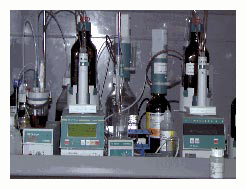|
|
The sulphur residues which are a by product of the combustion process enter the oil by way of blow-by.TweetThey then combine with oxygen from the air and moisture, to produce acids which if left unchecked will etch metal components in the engine. Consequently, when we buy new engine oil, it has a ‘base reserve’ built in to the additive package, which is designed to neutralise the acids as they are produced. As with all acid base reactions, the ‘base reserve’ is used up in the process of neutralising these acids. This Base reserve is called the TOTAL BASE NUMBER which is a measure of the level of BASE in the oil and is determined by measuring the amount of Potassium Hydroxide in mg taken to neutralise the base reserve in 1 gram of oil (mgKOH/gm). In the average engine oil, the starting TBN is usually around 6 to 9, however if we are looking to extended drain interval oils, we need to increase the initial TBN so we don’t allow the reserve to be depleted before the oil is drained. In some oils, a starting TBN 15 is not un-common and a depletion level should never get below TBN 3, which is a signal to change the oil.
Have your TBN checked periodically in your engine to monitor combustion efficiency. Remember when practicing extended drain intervals in engines, always have your TBN checked, which with viscosity is used as a drain indicator.
|

 TBN is also a useful tool in assessing an engines combustion efficiency, if rapid depletion is observed. If an engine’s combustion is inefficient, unburned diesel will enter the oil as blow-by, forming acids and using up TBN reserves. Exhaust emissions will often be visible as excessive smoke which in extreme cases will form ‘wet’ soot with large soot particles on the exhaust which will have a detrimental effect on engine wear.
TBN is also a useful tool in assessing an engines combustion efficiency, if rapid depletion is observed. If an engine’s combustion is inefficient, unburned diesel will enter the oil as blow-by, forming acids and using up TBN reserves. Exhaust emissions will often be visible as excessive smoke which in extreme cases will form ‘wet’ soot with large soot particles on the exhaust which will have a detrimental effect on engine wear.